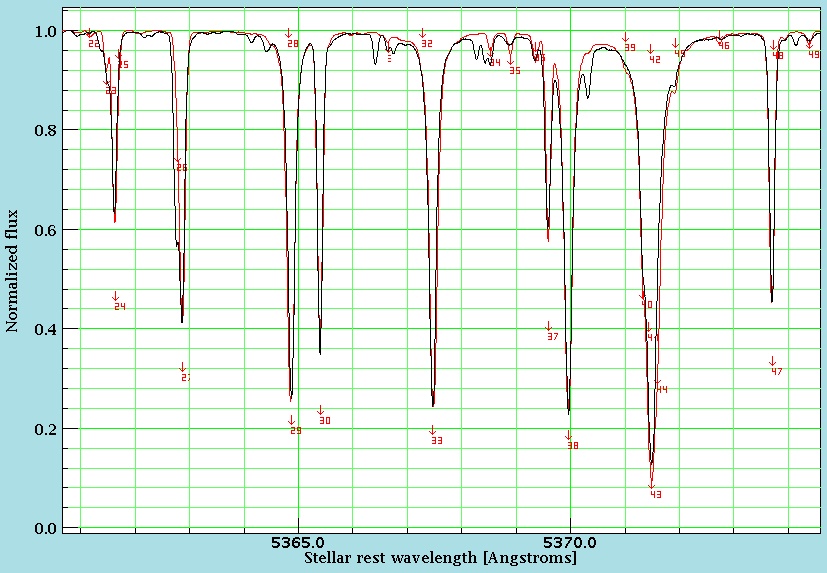Scanspec Code
Code Development
The Scanspec code is a radiative transport code I continue to develop to compute the UV, optical, and near-IR high-resolution spectra of stars, and star-like astrophysical objects. It is an all-round spectral synthesis code that can compute a complete stellar spectrum from atomic transition input data for very large amounts of spectral lines. The transfer equation is solved in one geometric dimension through a model of the thermodynamic structure of the atmosphere or circumstellar environment of the star. Scanspec iteratively solves the Milne-Eddington transfer equation with a LTE equation of state. The equation of state currently includes all spectroscopically important elements. Important line broadening effects for strong resonance lines, and the stellar continua are treated which also includes the use of opacity distribution functions. The line-of-sight microturbulence velocity is assumed to be constant with depth in the atmosphere model.
Scanspec is based on the older Scan code, which originates from research collaborations of Utrecht Univ. in The Netherlands and the Univ. of Brussels in Belgium. Scan has been (and still is) extensively used in studies of microturbulence velocities in massive cool stars. It accurately determines atmospheric model parameters (effective temperature, gravity acceleration, and metallicity) using input lists of identified spectral lines of which the equivalent line widths are measured in observed spectra. In the method of "spectral diagnostics" the atmospheric model parameters are varied until a best match between observed and calculated equivalent width values is obtained. As Nieuwenhuijzen and de Jager, A&A, 353, 163-176 (2000) point out in Section 2.3: "We use Kurucz models (Kurucz 1979) for the LTE, plane parallel atmospheres, and a code `Scan', developed from a code initially produced at Kiel (Baschek et al. 1966), adapted by Burger (1976), further modified by P. Mulder in 1983, by P. van Hoof, rewritten by C. de Jager, H. Nieuwenhuijzen and L. Achmad in 1990 (unpublished), to find the integrated line intensities (`equivalent widths') of selected lines. We use this code to generate a list of equivalent widths for a grid of models for two different values of microturbulence." Over the years I further adapted the Scan code by adding a detailed spectral synthesis calculation (called Scanspec) with more species, including the opacities of important di-atomic molecules for cool stars. The input line lists are mostly from the VALD database, but more recently I also commenced to measure and correct the oscillator strength values of many optical absorption lines in the solar spectrum (see the left-hand panel of Fig. 1) to improve line identifications in high-resolution cool star spectra.
Results
Scanspec has extensively been used and tested to calculate cool star optical and near-IR spectra. After 2000 the new TiO line list compiled by Schwenke considerably improved the detailed synthesis of M-star spectra dominated by TiO opacity (i.e. see red supergiant Betelgeuse in the right-hand panel of Fig. 1). The code is currently used to define optical atlases of spectral standard stars that are compared to high-resolution spectroscopic observations. The bright 'standard' stars that are currently selected as primary spectroscopic reference objects are: Betelgeuse (Alpha Ori; M2 Iab), Arcturus (Alpha Boo; K1 III), The Sun (G2 V), Beta Aqr (G0 Ib), Procyon (Alpha CMi A; F5 IV-V), and Canopus (Alpha Car; F0 II). Their effective temperatures differ by about 1000 K, ranging from 3500 K (M-type) to 7500 K (F-type). These stars offer a broad range of thermal conditions for the identification of mainly neutral and singly ionized spectral lines formed in their atmospheres. The observed and best fit spectra computed with Scanspec are available online in the interactive database SpectroWeb. The optical spectra calculated for these bright stars can correctly match the observed spectra over hundreds of angstroms in the wavelength scale which permits a reliable identification of many absorption features due to individual spectral lines or blends of lines. The theoretical spectra Scanspec computes are of very good quality and are currently used to measure and adapt the log(gf)-values of many weak and strong absorption lines of iron-group elements in the spectrum of the Sun and Procyon. Current code improvements also include hyperfine line splitting and explores the implementation of a more advanced opacity sampling technique.


Figure 1: Left-hand panel: Small portion of the solar optical spectrum observed with the KPNO Fourier Transform Spectrograph (solid
black line) that is best fit with a synthetic spectrum computed with Scanspec (solid red line). Many spectral lines correctly fit and individual
lines or blends of lines are identified in the online SpectroWeb database.
Left-hand panel: The lower panel shows the best fit (red line) with Scanspec to a portion of the optical spectrum of Betelgeuse (black line) around a
molecular bandhead of TiO. The upper panel shows a fit to the near-UV spectrum of Betelgeuse using a model of its extended chromosphere. An LTE
synthesis with Scanspec can be used to identify various absorption and emission features in the spectrum (e.g. strong Fe and Cr emission lines) we select
for more advanced non-LTE radiative transfer modeling of the detailed line profiles.
Read more: The SpectroWeb Database
Read more: Atomic Data for Spectral Standard Stars
Selected Papers
- Lobel A., Achmad L., de Jager C., & Nieuwenhuijzen H., 1992, Astronomy & Astrophysics, 256, 159, Atmospheric Model and Dynamical State of the Atmosphere of the Supergiant Eta Leonis (A0Ib). PDF ADS
- Lobel, A. 2001, Spatially resolved STIS Spectroscopy of Betelgeuse: Evidence for Non-Radial Chromospheric Oscillation from Detailed Modeling, Astronomical Society of the Pacific Conf. Ser., 242, 241, Jul 2000, Hven, Sweden. PDF ADS